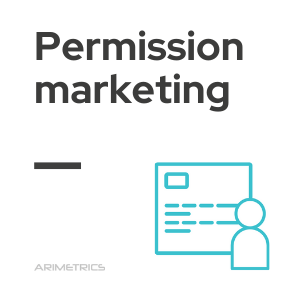Definition:
 Permission marketing consists of sending messages aimed at people who have said yes to a brand. It is very different from an advertisement on television, on the radio or a billboard, whose audience will be more general and has not been previously selected because it has not given its consent.
Permission marketing consists of sending messages aimed at people who have said yes to a brand. It is very different from an advertisement on television, on the radio or a billboard, whose audience will be more general and has not been previously selected because it has not given its consent.
For example, it would be when a brand launches a message to its followers on social networks. Well, being their followers it is understood that this audience has given permission to know and know more about said brand.
Origin of the term
Who first talked about the concept Permission Marketing was Seth Godin, who describes it as “the privilege, not the right, to deliver early, personal and relevant messages to the people who really want them”.
With email permission marketing, the user is the one who decides, voluntarily, to receive advertising messages from a certain brand or company. This means that if you have given this permission it is because you have an interest in that company or products and want to receive more information.
Therefore, this strategy focuses on getting this permission from the customer to offer you the content and information in which you are interested. In this way the company also obtains valuable information. You get to know the preferences of your audience and you will be able to detail more about the product or service you are going to offer. This may be their biggest differentiation from the competition.
Advantages of using this method
With this method you stop being intrusive with marketing to move to a strategy that seeks to attract your attention from the consumer and attract you more with a two-way communication. Therefore, we must be careful and not saturate the user with information. The user is waiting to receive information thanks to the trust and attention that has been achieved. The strategy then will be to keep this point active and even improve it. This way you get not only to be in your mind, but to be a prescriber of the brand.
You can store the information and segment it in databases in a way that allows you to be more orderly and have more value. You can store the information and segment it in databases in a way that allows you to be more orderly and have more value. Through an active conversation, more and more information about the user will be obtained and more interesting content will be offered to each consumer.
Permission Marketing Tools
Among the tools used in Permission Marketing are:
- Email lists: Email lists are central to Permission Marketing. By collecting email addresses of users who have consented to receive information, brands can send personalized and relevant messages. This includes promotions, product updates and educational content. The key is to segment these lists based on user preferences and behaviors, allowing for more targeted and effective messaging.
- Newsletters. Newsletters are newsletters sent periodically to subscribers who have opted-in to receive content from a brand. These communications can include articles, tips, industry news and special offers. By providing valuable and relevant content, brands can keep subscribers engaged and foster a long-term relationship. In addition, newsletters allow engagement to be measured through metrics such as open and click-through rates.
- Social Media: Social media is a powerful tool for Permission Marketing, as it allows brands to interact directly with their followers. By following a brand on platforms such as Facebook, Instagram or Twitter, users have given their implicit consent to receive updates and content. Brands can use these platforms to share engaging content, answer questions and encourage participation, thus creating an engaged community around the brand.
- YouTube: YouTube has become a key platform for Permission Marketing, especially for brands that want to share content in video format. By subscribing to a channel, users express their interest in receiving updates on new videos. Brands can use this medium to offer tutorials, product demonstrations and behind-the-scenes content, which helps build a deeper connection with their audience. In addition, video content can be highly shareable, extending a brand’s reach.
- Webinars: Webinars are online events that allow brands to interact in real time with their audience. By registering for a webinar, participants give their permission to receive additional information and updates from the brand. These events can address topics relevant to the audience and offer value through educational content. Webinars can also generate leads, as attendees may be interested in related products or services.
